Planting and leaving
Cinquefoil is an unpretentious, frost-resistant, drought-resistant plant, not demanding to care for. Since in nature it grows in different conditions, then it can also be planted in the country where it is convenient. However, the best place to "settle" is the sunny part with shade in the afternoon. Bushes with yellow and white flowers are especially demanding on the sun. Potentilla blooming in pink and red, on the contrary, prefer shade - in the bright sun, the flowers fade, lose their presentability and appearance.
If the cinquefoil is grown from seeds, then the soil for planting is prepared in advance. Weeds are removed from it, it is fluffed, diluted with sand, filled with humus and fertilizers. The optimal planting time is spring. The seeds should not be deeply buried and should be well watered. When the plants sprout, they are planted at a distance of 0.3 meters.
The cinquefoil also reproduces by cuttings, which are cut from the end of June to the end of July. To root them is simple: they are planted under a film or jar. It is better to determine them for a permanent place in the spring. Also, the creeping branch can be dug in with earth, and at the beginning of the summer cottage season, the rooted branch can be separated from the "mother". The rooting cuttings should not be allowed to bloom - this negatively affects root formation.
Caring for a planted plant is simple. The ground under the bush is loosened and cleared of weeds. Several times during the season, Potentilla is watered, and in drought it is recommended to moisten the shoots in the evening. To retain moisture, the ground under the bush is mulched. This has another benefit - then weed control is minimized. Top dressing is also included in the set of activities. To do this, 0.025 kg of phosphorus and potash fertilizers are diluted in a bucket of water and each bush is watered with this amount.
Reproduction methods of Potentilla
Cinquefoil reproduces by:
- seeds;
- layering;
- dividing the bush;
- cuttings.
The choice of method depends on the preferences and capabilities of each gardener.
Seeds
It is not difficult to propagate cinquefoil by seeds, and this method is suitable for both novice gardeners and experienced professionals. The method is considered the most time-consuming, but, with due observance of all stages, it is in no way inferior in efficiency to the rest of the options.
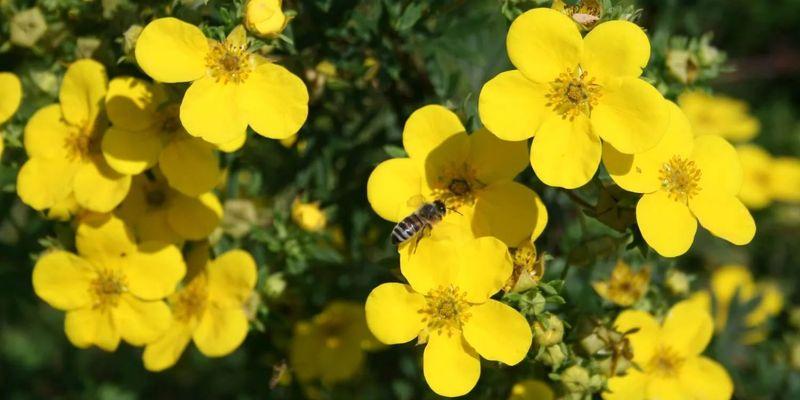
Layers
It is used in summer, when young, flexible shoots are formed on the bush. The process of reproduction by layering is as follows:
- the lower part of the shoots, in places of contact with the ground, is trimmed;
- the shoots prepared in this way are sprinkled with a layer of fertile soil and fixed with a stone or a metal bracket;
- after a year, the cuttings are separated from the main bush and planted as an independent plant.

By dividing the bush
Reproduction by dividing the bush is carried out either in the fall or in the spring. In the fall, it is allowed to propagate Potentilla in a similar way only in regions with a warm climate. To divide the bush, you must:
- dig in a bush on one side;
- extract part of the roots with shoots, carefully separating them with a hatchet or shovel;
- the main bush is covered with earth, and the extracted shoots are cut to a height of up to 30 centimeters, after which they are transplanted to a previously prepared place.
Many varieties of Potentilla, including pink, lend themselves well to this method.
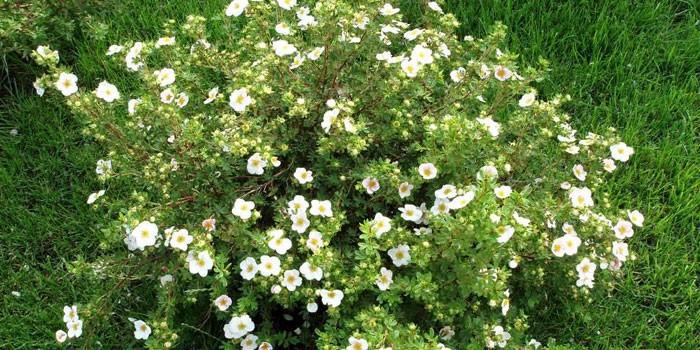
Cuttings
As cuttings for breeding, any shoots are suitable - both young and mature, which have managed to become stiff. Cuttings are separated from a healthy, disease-free bush. Cuttings are carried out together with the leaves, since it is in them that all vital processes for this method take place.
How to prune cinquefoil in spring
Of course, the spring period is the most favorable for cutting Potentilla shrub, especially when it comes to northern regions. After all, it is precisely the many dense branches left on the bush for the winter that can retain a large amount of snow on themselves and contribute to a better overwintering of plants.
Timing
The best period for spring pruning of shrub Potentilla is the month from mid-March to mid-April, when the buds have not yet swelled on the bush. Pruning Kuril tea during this period not only does no harm to plants, but also stimulates the growth of shoots as much as possible.
The only difficulty in pruning Potentilla shrub in the spring is that the branches look still lifeless and sometimes it is difficult to distinguish a live shoot from a dried one, especially for beginners. In this case, it is recommended to wait for the first sap flow and swelling of the buds on the cinquefoil and after that start pruning.
Preparation of tools and materials
The most important tool that will be needed when pruning Potentilla shrub is a sharp pruner. Before work, it must be sharpened well and, if necessary, lubricated if there are areas with rust on it. The pruner should be quite powerful, since the old branches of Kuril tea can reach a thickness of 0.8-1.2 cm.
If the main purpose of pruning is to form the exact shapes of a Potentilla bush or a whole hedge from it, then you will need to stock up on a tape measure.
A fan rake will be needed to clear the bushes themselves and the soil surface under them.
It is advisable to use garden gloves to protect the skin of the hands when pruning.
How to prune Kuril tea in spring (pruning rules)
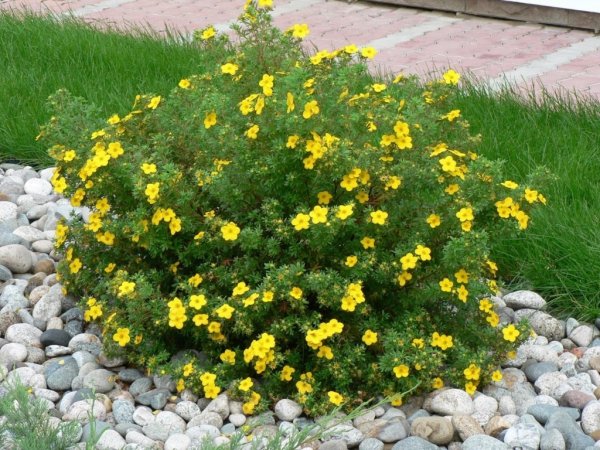
The first action that is performed when pruning Potentilla in a shrub spring is to remove blackened inflorescences from the ends of the shoots, as well as obviously dry and broken off branches. In the spring, the ends of the frozen twigs are also removed, up to the first green spot on them.
Then it is advisable to take a closer look at the very old shoots and cut at least a few of them at the very base of the bush. This operation will slightly rejuvenate the plant.
Formative pruning is the last step. If the procedure is carried out for the first time, then the required shape and size of the bush is approximately measured. It can be a ball, an oval, or even a cube. Then they begin to shorten all the branches that protrude beyond the intended limits. If the shape of a bush or hedge was already formed in previous years, then only strongly protruding branches are cut off, and all other shoots are only shortened by ¼-1/3 of their length. The shape may need to be corrected if the lighting conditions were uneven and one part of the bushes strongly outgrew another. The video below describes in detail and shows a scheme for pruning Potentilla in the spring.
When pruning Kuril tea, it is important to observe the following rules:
- Before the start of pruning, the land under the cinquefoil shrub is freed from plant debris using a fan rake.
- They also comb the bushes themselves in order to remove the obviously dry and lifeless forms.
- Branches should not be cut more than halfway, the ideal proportion is no more than 1/3 of their length.
- It is advisable to remove broken and old branches entirely, near the ground. Slices, when removed, are lubricated with garden pitch.
- Weakened bushes are cut as close to the ground as possible, while with strong plants they act in exactly the opposite way.
- The cuts should be straight, no burrs or lacerations should be left on the branches.
Forming and pruning when growing garden shrubs
Usually the gardener himself decides whether he likes the look of the plant or not, hence the need for pruning.It is not difficult for a person, even with little knowledge of the plant, to determine the defects that need to be eliminated: damaged by severe frost, freezing rain or simply broken branches, dry and rubbing shoots, rotting branches, protruding branches, especially on clipped hedges.
Sanitary pruning when growing shrubs (removing broken and damaged branches) can be done at any time. In other cases, it should be borne in mind that plants such as forsythia, mock orange, honeysuckle, some types of spirits, lilacs and others, lay buds on last year's shoots, and bloom in early spring or early summer.
They should only be cut off after flowering. And such plants as privet, roses, hydrangea, David's buddley, snowberry and others, which bloom in summer and autumn, are pruned in early spring.
Different types of plants react differently to pruning, since the shape of the crown of the shrub is of great importance, which can be either pyramidal, or spherical, or creeping, etc. For example, in Hungarian lilacs, cotoneaster, honeysuckle, after low pruning, new shoots appear along the entire length of the branches, and in rhododendrons, yellow roses, low pruning causes the death of entire branches and even the entire bush, since these plants do not have the property of bud formation on the lower old branches.
When growing shrubs in a nursery, shaping is carried out in the first years of their life. In the future, after planting them in a permanent place, they begin sanitary, formative and rejuvenating pruning. When pruning shrubs, plant growth is usually weakened or enhanced, flowering and fruiting is accelerated or slowed down, and the desired crown shape is improved or created.
The degree of pruning is very different: from removing wilted flowers from lilacs or roses to pruning large skeletal branches of fruit crops, as well as rejuvenating pruning of old shrubs. It should be remembered that pruning for plants is the same surgical operation, and before proceeding with it, the gardener must know exactly if it is needed and what he wants to achieve with this operation.
This is especially important for breeds such as honeysuckle, lilac, hawthorn, buckthorn, hazel, predisposed to develop a central shoot to the detriment of lateral ones. At the same time, barberry, spiraea, cotoneaster, cinquefoil bush well and without pruning.
But, if you want to get a particularly lush specimen or give it some original shape, pruning of berry and ornamental shrubs should be done in the spring, before the buds begin to bloom.
Popular plant varieties
Most often, flower growers breed semi-shrub and shrub types of tea, dazzling with flowers of a wide variety of colors: from white and yellow to orange and red. Mostly shrubs that are planted in curbs, hedges and on alpine hills, bloom in late May with tender yellow buds. The most popular variety is Goldfinger, which you can read in more detail in our article. But, besides him, the following varieties take root and grow well in a temperate climatic zone:
-
"Abbotswood", which grows into a sprawling shrub up to one meter high. The green cap of the plant is strewn with medium-sized white flowers. The color of the leaves is faded, light green in color. The bush is well suited for creating a decorative alpine slide. But when planting, it must be borne in mind that a small seedling grows well not only in height, it can reach up to one and a half meters in diameter. If the bush is properly formed, it keeps well its spherical or rectangular shape. This variety is one of the most requested in garden shops due to its beauty and unpretentiousness.
Abbotswood Kuril tea
-
"Marion Red Rubin" refers to medium-sized varieties, reaching a height of only half a meter. The crown diameter can be no more than a meter. With timely pruning, it keeps its shape well, gives a dense crown of young shoots.Blooms in early summer with large bright red flowers with yellow stamens. Sometimes the color of the flowers can go orange. The diameter of the petals is almost 3.5 cm. The variety is frost-resistant, blooms until frost, tolerates winter well.
Kuril tea varieties marion red rubin
-
"Guildford Cream" is distinguished by its large white flowers. The tall bush begins to bloom in early summer and ends in September-October. It looks very picturesque due to the combination of creamy white flowers against a background of lush greenery. The variety tolerates pruning well, launching new young shoots, looks larger and brighter.
Guildford cream Kuril tea
-
Happy Orange is a striking representative of shrub Potentilla. If gardeners manage to get and grow this variety, then a very bright bush, dotted with marigold flowers, appears in the garden. Bright flowers are an indisputable advantage of the species. They are warm orange in color with bright streaks. Flowers look large against a background of small leaves. An adult plant reaches a height of 90-100 cm. The variety has proven itself well in regions with severe and early winter, it is quite resistant to diseases.
Happy orange Kuril tea
-
Pink Beauty is one of the new varieties of Kuril tea, quickly gaining admirers due to the unusual color of flowers, the overall beautiful shape of the bush and the delicate combination of pink flowers, light green buds and dark small leaves. The buds open with the arrival of spring heat, reaching 3 cm in diameter. The petals are bright in color, do not fade in the sun. Closer to autumn, the flowers acquire a more intense shade. The plant tolerates winter well, blooms almost to frost. The height and width of the shrub is approximately the same, no more than 80 cm. If you have purchased a varietal plant and are thinking whether it is necessary to cut Kuril tea for the winter, whether it will harm it, then the advice of experienced agricultural technicians will help you make a decision.
Kuril pink beauty tea
Potentilla care
Cinquefoil is very popular in landscape design due to its unpretentious care. The plant needs regular weeding, loosening of the soil and timely watering during a drought. And if you mulch the plantings with peat or sawdust in the spring, then these manipulations can be done less often.
To achieve lush flowering, it is recommended to feed the cinquefoil in May, July and at the end of August with a complex mineral fertilizer for flowering plants. Although on fertile soil, it grows well without additional fertilizing. However, flower growers still recommend at least once a year (in spring) to apply phosphorus and potassium sulfate under each adult bush (25-30 g of each fertilizer per 10 liters of water). Consumption - 1 bucket per plant.
Erect cinquefoil, or galangal
In dry summers, the plant becomes "stuffy", so it often fades quickly. To prevent this from happening, every evening after sultry weather, Potentilla is sprayed with water from a spray bottle. Then flowering will be longer.
With good care, diseases and pests do not bother the cinquefoil. In exceptional cases, the plant can be attacked by rust, spotting and powdery mildew. Any fungicide (Bordeaux liquid, Fitosporin-M) can easily cope with these fungal diseases.
Of the pests on the cinquefoil, scoops can be found. An insecticide (Decis, Fitoverm) will help to cope with them. A few sprays with an interval of 2 weeks are enough.
Adult plants (both herbaceous and shrub Potentilla) do not need shelter for the winter. Only cuttings rooted this year and young seedlings are insulated.
When is it necessary to transplant Potentilla
Two periods are suitable for transplanting Potentilla:
- autumn;
- Spring.
It is better to transplant those bushes that have reached the age of at least three years. The preparation of the transplant site is carried out in a manner similar to the preparation for planting a young bush.
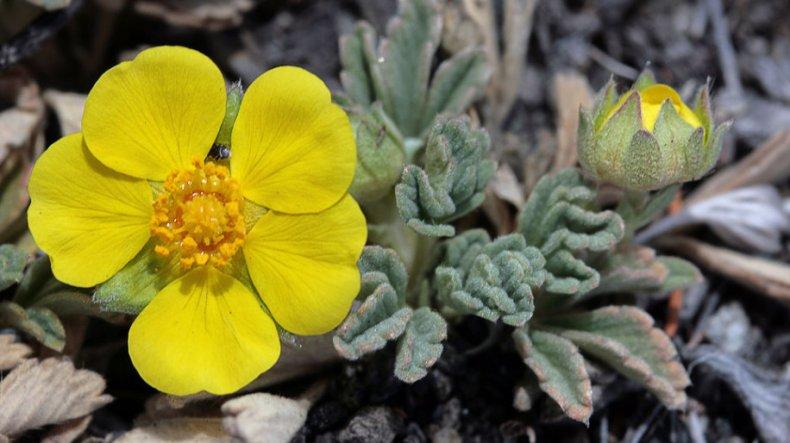
Autumn transplant
Autumn transplantation is carried out in the last days of August, early September.This time is most optimal, and the plant will have time to take root in a new place before the onset of cold weather. It is not recommended to make an autumn transplant in regions with poor climatic conditions.
Transplant in spring
In the spring, it is allowed to transplant Potentilla in any growing regions. The best time is considered to be the period when the snow has completely melted and the soil thawed after the winter frosts. The transplant is carried out in the usual way and does not have any peculiarities or nuances.

How to prune shrub cinquefoil in the fall
Autumn is also a good time for pruning Potentilla shrub, since the plants are gradually beginning to retire, but they are still clearly visible alive and non-living (diseased) branches, which must be got rid of as soon as possible.
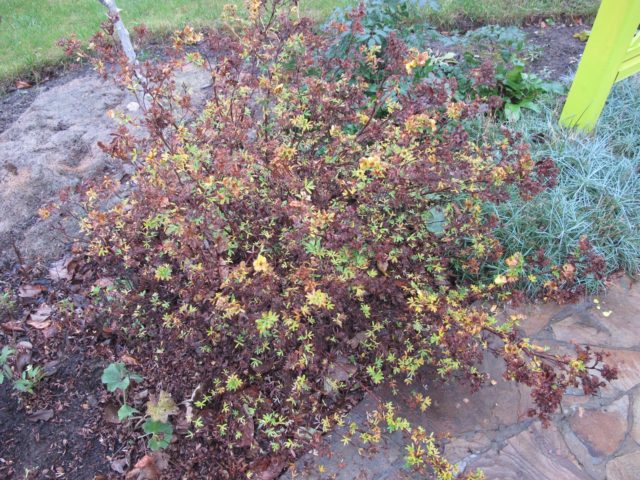
Why do you need to cut cinquefoil in the fall
In autumn, cinquefoil shrub can be cut to rejuvenate the bush or to give it a certain shape. After all, if you complete the pruning before the constant snow falls, then in the spring the Potentilla shrub will appear in a completely perfect condition, and there will be no need to carve out time for it in the overly busy spring time filled with other gardening concerns.
Timing
Autumn pruning is usually carried out after the last flowers wither or before the threat of frost and permanent snow cover. Calendar dates can vary greatly from region to region. But most often this happens between the end of September and the beginning of November.
Rules for pruning Kuril tea in the fall
As a rule, sanitary pruning in the fall is not particularly necessary, especially if it was carried out in the spring. But if by this moment broken branches or shoots with signs of diseases have appeared on the bushes of Potentilla shrub, they must be cut out.
If in the spring it was not possible to carry out the formative pruning for one reason or another, then in the fall they do the same operations with Kuril tea as listed above. If in the spring the bushes were already formed, then the essence of autumn pruning comes down to the fact that all branches that protrude beyond the previously defined boundaries are cut off.
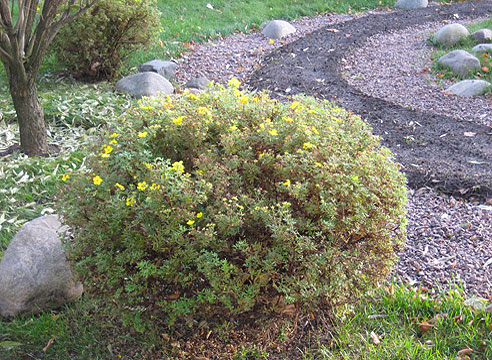
Terms and purpose of work
To understand in what time frame it is best to cut the Potentilla bush, you need to decide on the appointment of a haircut. In total, there are 3 types of pruning of Kuril tea.
Sanitary pruning
It is a preventive measure against various diseases, prevents a massive attack of harmful insects. It consists in removing all dried, broken off or parasitized branches. In addition, wilted peduncles are also cut off. Sanitary pruning is carried out throughout the growing season: spring, summer and autumn.
Rejuvenating procedure
It is carried out to extend the life of the plant and improve its decorative properties. It is carried out every 5-7 years in late autumn or early spring before the start of sap flow. The procedure is also known as a stump cut of the Potentilla. Only those bushes that have taken root well at the planting site and are more than one year old can be trimmed in this way.
Usually the procedure is divided into 3 stages:
- with the onset of autumn, 5 large old branches are removed, cutting them at the root and leaving hemp up to 15 cm in length;
- a year later, ½ of the remaining branches are removed in the same way;
- the third stage of pruning is carried out a year later, removing the remaining branches.
This promotes gradual rejuvenation of the bush and prevents plant depletion.
Formative (decorative) pruning
As the name implies, it is produced to give a beautiful shape to the Potentilla bush and stimulate its flowering. Dates - May-October, that is, the entire vegetative period. You can trim a single plant into a ball or any other, or a group of hedges.
Let's tell a little more how to give a decorative shape to a bush.First, decide what it will be: a ball, cube or rectangle. We recommend starting with these simple geometric shapes, and when you become a pro in this business, you can give free rein to your imagination and cut the cinquefoil more creatively.
There are 2 ways to create a shape: "by eye" and wireframe. With the first option, everything is clear: you focus only on your vision of the future figure and remove everything unnecessary. The wireframe method involves making a wire model that is put on the plant, and all branches that go beyond it are clipped.
Pruning Potentilla shrub in spring
It is better to use a sufficiently powerful pruner as a tool, since the oldest branches reach 0.7-1.2 cm in diameter. You can cut your hair in the fall, before installing the snow cover. In this case, in March-April, you will see a neat crown of a shrub that will not require your attention during the busy spring days for the gardener. However, in colder latitudes, in the middle lane, it is better to prune in the spring. Old branches of a dense shrub will contribute well to snow retention, and the plant will better tolerate frosts.
Use a fan rake to clear old foliage and grass around the bush. With the same rake, you can "comb" the branches of Potentilla, removing last year's leaves and flowers that have dried on them.
Examine the shape of the plant, determine the degree of shortening of the branches. If the plant was more in the sun on one side and in the shade on the other, it could form its crown not symmetrically. In this case, to give the correct rounded shape, the branches will not be cut equally from different sides. The main thing is that as a result of cutting, the branches of the bush become the same length, which will create the shape of a ball.
When cutting Potentilla, proceed from the rule that the branches should not be shortened by more than half, the best option is by a third. Remove old broken and dried branches entirely, treat the cuts with garden pitch.
Cutting Potentilla stimulates profuse flowering. It is advisable to feed the plant in the period after the shearing, when the first green leaves begin to appear on the branches. Potentilla reacts well to spring feeding with phosphate fertilizer (25 grams per 10 liters of water) and potassium sulfate (30 grams per 8-10 liters of water). In a dry summer, Potentilla needs a cool shower, so do not go around it with a hose when watering, but take a good shower over its crown. By comparing the photos before and after the haircut, you can clearly see that a well-groomed look can be given to the plant by spending only 15-20 minutes working with a pruner.
Pruning Potentilla: timing and methods of carrying out, useful recommendations
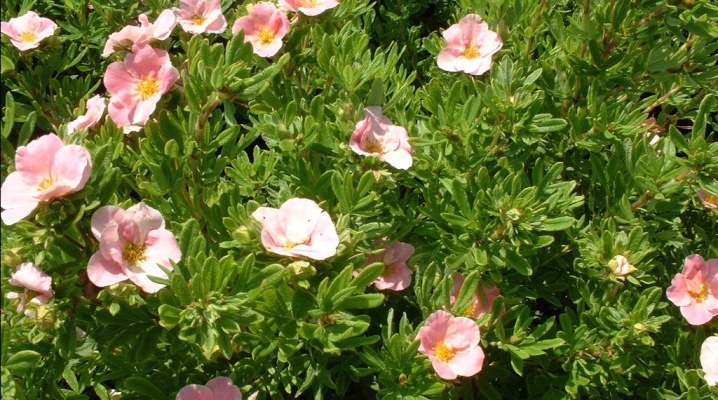
Ornamental flowering plants, undoubtedly, are an adornment of any personal plot. Some of them are quite capricious, and it is difficult to cultivate them, while others, on the contrary, do not need special care and are able to delight their owner for many years. The latter include shrub cinquefoil, or Kuril tea. It is a perennial (its life span can exceed 20 years), various varieties have different parameters (50-100 cm in width and height).
However, any of the varieties needs timely pruning in order to maintain an attractive appearance. Read about how to make it correctly in our material.
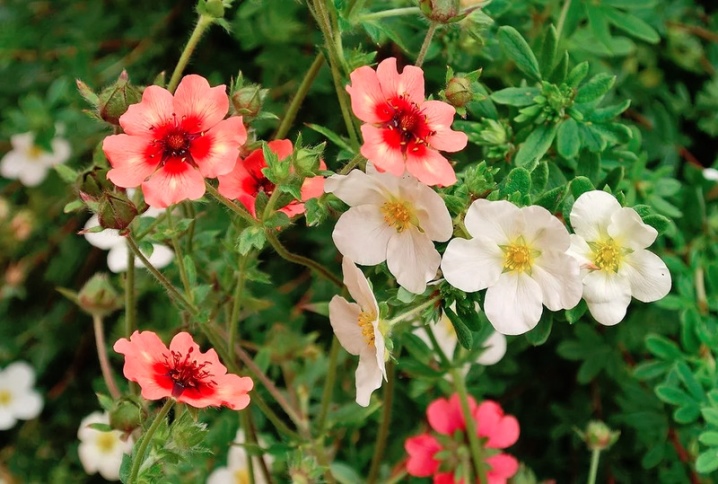
Features of caring for cinquefoil shrubs in the garden
Caring for cinquefoil will be minimized if, after planting, you mulched the plant's near-stem circle. In this case, the weeds will not grow abundantly. Loosening the soil is mandatory, but do it very carefully so as not to snag the roots of the plant.
How often and what to feed
How and what to feed Potentilla:
- During the period of development and growth, in the spring, potassium (sulfate) and phosphate are introduced. Dilute the compositions of 30 g per bucket of water (per bush).
- During the formation of buds, the plant is fed with potassium-phosphorus fertilizer. Any composition can be purchased for flowering plants.
Top dressing is carried out 4 times a season. If possible, use an infusion of mullein with ash.
How to prune shrub cinquefoil
Pruning Potentilla shrub is carried out either in spring or in autumn. Broken, dry and weak branches are removed from the bush. To give a certain shape, branches are removed that protrude from the general shape of the crown. Old bushes (over 7 years old) rejuvenate by cutting off old shoots up to a third of their length. Rejuvenate every year until the bush is completely renewed.
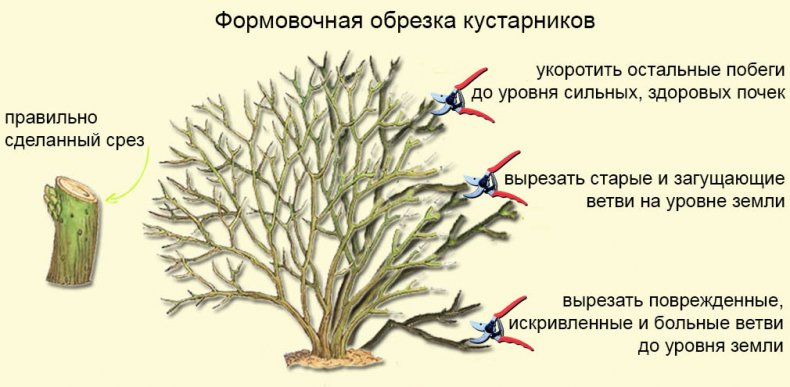
Spring pruning of Kuril tea
It is possible to form the crown of Kuril tea in spring according to the principle of shaping and sanitary pruning. To carry out the procedure, you will need the same tools: a pruner, a fan rake, mittens, a tape measure and a bag for collecting leaves and branches. You also need to prepare a garden pitch in case you have to cut off large branches that will need to be covered with pitch in order to avoid infection. It is imperative to have time to carry out the pruning before the buds open. This moment is easy enough to miss.
It is important to notice the beginning of bud swelling, which will allow you to see dry and frozen branches. You will need to get rid of them with a pruner.
When pruning, remember that you cannot shorten the shoots too much. It is enough to cut the twigs by a third. Pruning in spring will give the plant the opportunity to grow young green shoots, making the bush look fluffy and shaped.
Sequence of work:
- Cleaning of last year's leaves and flowers. Under the layer of melted snow from last year, there could be fallen leaves. Also, a few small leaves and dried buds and flowers always remain on the bush. They are completely useless on a spring bush that is about to bloom. They must be removed to obtain a beautiful appearance in the plant. To do this, with a fan rake, first comb the crown of Potentilla, removing dry leaves and buds. And then we scoop out all the dry foliage from under the bush.
- Crown shaping. Before picking up the pruner, be sure to carefully examine the Kuril tea: whether the branches grew symmetrically during the last season or because of the shade the bush did not form evenly, how much you can shorten the branches so as not to spoil the decorative appearance if the bushes grow in the form hedge, then you need to measure the height to which you need to trim all the greens equally.
- Removal of dry branches. The one-third pruning rule does not work when removing dry and frozen branches. They need to be cut out completely. In this case, large sections must be covered with pitch. Don't rule out this simple procedure as unnecessary. In the future, it will allow avoiding many problems with the penetration of viruses and pathogens.
- Leaving after a haircut. All cut shoots must be immediately put into a bag along with the foliage. They cannot be left under a bush. All tools, especially pruning shears, must be processed not only before trimming, but also after (wipe with alcohol, vitriol or ignite). And with the onset of favorable weather conditions, fertilizers must be applied at the root. They will help build up green mass and plant buds.
Follow-up care
Kuril tea is a popular shrub. With its help, you can form hedges, create compositions with other decorative flowering plants or plant bushes one by one. He is unpretentious in care, but you still have to carry out some procedures.
- Weed the plantings regularly, loosen the soil in the near-stem circle of each plant, water abundantly during the dry season.
- Spring mulching with peat or wood shavings is recommended - then you will do all the above actions less often.
- If you want Kuril tea to begin to bloom profusely, feed it with a complex mineral mixture designed for flowering plants.
- If the summer is hot outside, Potentilla may begin to shed flowers. To avoid this, sprinkle it with water from a spray bottle every day in the evening. Then the plant will "breathe" and flowering will continue.
- If you follow all the rules for caring for Kuril tea, it will delight you with good health. However, there are diseases that this plant is most susceptible to: ash, rust and spotting. They can be dealt with by treatment with a fungicidal preparation - Bordeaux liquid, "Fitosporin".
- Of the harmful insects, scoops (bat) bother the bushes most of all. These are moths, whose voracious larvae can practically destroy the plant by eating its foliage and damaging the root system. To combat them, purchase an insecticidal agent - "Fitoverm", "Decis" - and process the planting every 1.5-2 weeks.
- Earlier we said that shrub cinquefoil is a frost-resistant plant that does not need winter shelter. However, this applies only to adult, well-rooted bushes - young growth needs to be insulated with fallen leaves.


For information on how to trim Potentilla, see the next video.


